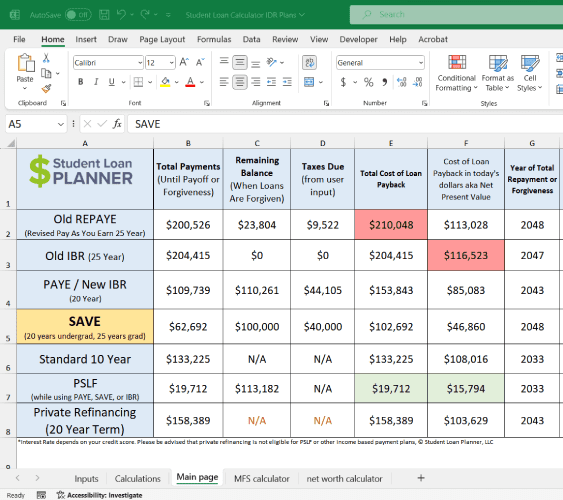
It's not a popular topic to discuss, but death is a reality of life and can affect the repayment of your or a loved one's student loan debt. It's important to understand how student loan repayment works if a borrower dies. While the student loan balance is discharged in many cases, that's not always the case.
Here's a look at how various types of student loan debt are handled in the worst-case scenario that a borrower dies during repayment.
Federal student loans
All federal student loans are dischargeable upon a borrower’s death. The entirety of your federal loan balance is forgiven tax-free and ceases to exist. Your loved ones aren't on the hook to pay off your federal student loan debt. Hopefully, you'll never have to use this benefit, but it's important protection provided by the federal government.
Parent PLUS Loans
The same holds true for Parent PLUS Loans if you or your child dies since Parent PLUS Loans are under the federal student loan system. The government discharges the remaining loan balance as long as you provide proper documentation of the borrower’s death.
Note that Parent PLUS Loan discharge only applies to a parent or parents whose name is on the loan. For example, if you took out a PLUS Loan and your spouse, who isn’t a listed borrower, dies, you’re still required to pay back the loan balance.
If you took out a Parent PLUS Loan with the help of an endorser due to adverse credit, the endorser is free from financial obligation if the primary borrower dies. An endorser is the equivalent of a cosigner, but for PLUS Loans.
Previously, parents faced tax consequences if their Parent PLUS Loan was forgiven through a death discharge. The Tax Cuts and Jobs Act of 2017 made all student loan discharges due to death non-taxable. There’s no longer an IRS tax penalty if your Parent PLUS Loan is discharged due to the passing of a child beneficiary.
Private student loans
Private student loans are where loan discharge gets a little more complicated. Unfortunately, there's no hard rule across the board on how private lenders handle loan debt in the event of a borrower's death.
Some lenders offer discharge upon the death of the primary borrower, including:
- College Ave
- Earnest
- Sallie Mae
- SoFi
If your lender doesn't discharge the loan balance, the debt becomes part of the deceased's estate. Depending on the situation, estate assets could be used to pay off the remaining debt through a probate proceeding. Regardless, the debt isn't passed on to other family members.
Check your student loan agreement or with your lender to determine if loan discharge is an option if you die. In most cases, private lenders would need similar notice and documentation of death to approve a loan discharge.
Cosigned private student loans
If you've cosigned on a private student loan recently, you probably won't have to pay back the loan if the borrower dies. In 2018, Congress passed the Economic Growth, Regulatory Relief, and Consumer Protection Act that releases cosigners from financial obligations if the student borrower dies.
Loans taken out before this time, though, may carry different rules. Check with your lender to see if your cosigner is responsible for your loan if you die. Your lender might also offer a cosigner release after you’ve met specific requirements. Refinancing private student loans is another way to release a cosigner of any obligation.
If you took out a private student loan using a cosigner and your cosigner passes away, you must still pay back your loan.
A spouse’s student loans
In many cases, a surviving spouse isn't responsible for repaying student loans owed by a deceased spouse. If you cosigned on a spouse's loan, you might be required to pay it back if taken out before the previously mentioned law went into effect.
If you reside in a community property state, you might be required to repay private loans of a deceased spouse. States that fall under community property laws include:
- Arizona
- California
- Idaho
- Louisiana
- Nevada
- New Mexico
- Texas
- Washington
- Wisconsin
Unless you live in a community property state or another exception applies, you aren't responsible for debt owed by your deceased spouse.
Get Started With Our New IDR Calculator

How to report a death to your student loan servicer
To get approved for loan discharge, the borrower's family needs to provide acceptable proof of death, which may include:
- A death certificate.
- An official letter from the county clerk's office.
- Letter from a clergyman or funeral director.
- Confirmation of death from a consumer reporting agency.
- An obituary from a newspaper.
- Confirmation from the Social Security Administration’s death registry.
Contact your loan servicer to determine what's required to report a borrower's death and apply for loan discharge.
Protect your family today
If you have student loans, now is the time to ensure that your loan information is available for loved ones to save them the trouble of finding it later. Write down or share information with your family about your loan servicer, including their contact information and your account number.
Not sure what to do with your student loans?
Take our 11 question quiz to get a personalized recommendation for 2024 on whether you should pursue PSLF, Biden’s New IDR plan, or refinancing (including the one lender we think could give you the best rate).
